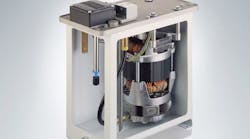For large machining centers, balancing the weight of spindle heads and workpiece tables saves energy — and, therefore, money. Hydraulic weight balancing is an automatic process and takes advantage of the fact that once a system is pressurized, it no longer requires additional energy input.
The hydraulic cylinder in a weight balancing system is connected to an accumulator, which becomes pressurized to compensate for the weight of the spindle head, workpiece table, or both. The pressure is set so the cylinder balances the weight and only friction force and inertia mass must be overcome to move the spindle head along its axis. This balancing of the spindle head and workpiece table requires significantly less power to drive, thus lower power consumption.
Hawe Hydraulics, Charlotte, N. C., provides a broad line of potential solutions such as this. For the weight-balancing application, Hawe’s compact MPN power unit provides high operating pressures for charging and discharging the system. Doing so lets designers specify a larger tank volume while maintaining a compact footprint for the power unit.
The MPN power unit can be configured with any of several valve circuit combinations and can be delivered as a complete system for installation directly into a preconfigured hydraulic weight balancing application. With Hawe Hydraulics’ counterbalance valves, even greater electrical power savings can be achieved.
For more information on MPN compact hydraulic power units and counterbalance valves, visit www.hawehydraulics.com.


